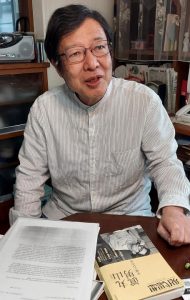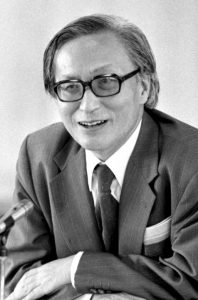An anti-nuclear life, Part 5: Masao Maruyama (political scientist, scholar of the history of Japanese political thought, 1914–1996)
May 23, 2024
Rejection of narcissism and desire for universality
A-bomb experience served as foundation for assertions
by Masakazu Domen, Senior Staff Writer
As a leader of postwar democratic thought in Japan, Masao Maruyama left behind a legacy that includes the publication Thought and Behavior in Modern Japanese Politics and many other important writings. Mr. Maruyama was an intellectual with a presence inside and outside academic circles. This year marks 110 years since his birth. Despite experiencing the atomic bombing in Hiroshima as a member of the military at the age of 31, he was known for his reticence to speak of his A-bombing experience.
One anecdote is illustrative of that fact. In 1983, a surgeon in Hiroshima City who read Mr. Maruyama’s Senchu to Sengo no Aida (in English, ‘Between the war and the postwar era’) sent a letter, asking him, “What exactly did the atomic bombing mean for you?” Mr. Maruyama replied, “I absolutely despise the Japanese culture (narcissism!) of laying bare and flaunting our own ‘experiences’ with such emotion. The harsher the A-bombing experience, the more this is the case.”
The tone was surprisingly harsh for a response to a reader he had never met. What were Mr. Maruyama’s thoughts behind his reply?
Takashi Kawamoto, 72, a native of Hiroshima who lives in the city’s Nishi Ward, is professor emeritus of social ethics at the University of Tokyo and Tohoku University. He has paid close attention to the association between Mr. Maruyama’s ideas and his experience in the atomic bombing. Regarding Mr. Maruyama’s reminiscence that he had “neglected to develop ideas based on his A-bombing experience,” Mr. Kawamoto said, “His words do not necessarily need to be taken at face value.”
For example, when the Korean War began in 1950, the citizens’ peace organization Heiwa Mondai Danwa-kai issued a declaration titled “Mitabi Heiwa ni-tsuite” (‘Third statement on peace’). In the chapter drafted by Mr. Maruyama, one passage reads, “The idealistic position that regards war as the greatest evil and peace as the greatest value has taken on a highly realistic meaning, as war has reached the stage of nuclear war.”
The eradication of war itself became not an ideal but a necessity with the advent of atomic and hydrogen bombs, a view Mr. Kawamoto sees as having a high degree of universality and at the same time being “supported by Mr. Maruyama’s experience of witnessing Hiroshima’s devastation in the atomic bombing.”
On the other hand, Mr. Maruyama expressed his stance of almost automatically rejecting the revealing of A-bombing experiences that might be perceived as ‘faith in reality.’ Mr. Kawamoto provided the American philosopher John Rawls (1921–2002), known for his major work A Theory of Justice, as a reference point for understanding Mr. Maruyama’s attitude. Mr. Kawamoto co-translated the book and is known for his research on Mr. Rawls.
In 1995, the U.S. Smithsonian National Air and Space Museum was planning an exhibit of materials related to the atomic bombings. However, the plan was fiercely opposed by veterans of World War II and others and wound up being stalled as a result. Based on that experience, Mr. Rawls contributed a piece to a U.S. magazine’s special issue titled “50 Years After Hiroshima.” In his writing, Mr. Rawls ethically questioned the atomic bombings from a variety of perspectives, concluding that the bombings represented a terrible moral wrong. That was a bold statement.
According to Mr. Kawamoto, “Mr. Rawls dared not touch on it in his article, but he had witnessed Hiroshima three months after the bombing.” He had been serving in the Philippines when the war ended and visited Japan on his way back home to the United States. Mr. Kawamoto said, “The circumstances were described in a letter to one of his students, which was published after Mr. Rawls’ death. He had also added that ethical judgments should be based on arguments that could convince anyone and not only on where the person had been.”
Both Mr. Maruyama and Mr. Rawls followed an arduous academic journey that spanned World War II. They might have imposed on themselves the “abstinence” of not expressing their personal experiences out of a desire for a universality that transcended nation and ethnicity.
“The Logic and Psychology of Ultra-nationalism,” an essay included at the beginning of Mr. Maruyama’s book Thought and Behavior in Modern Japanese Politics, cemented his reputation. The essay first appeared in the May 1946 issue of Sekai. It analyzed the “system of irresponsibility” that prevailed in the Imperial Japanese Army against the backdrop of extreme nationalism during the war. His ideas had a great impact on the people living on the scorched earth of the defeated land.
The essay concludes with a sentence describing August 15, the date the war ended, as being the day people were freed from ultra-nationalism. Given the timing of publication, the essay revolved around his war experiences and vivid emotions. Mr. Kawamoto said, “We can read between the lines about his experience of being arrested as a ‘thought criminal’ and his life in the military, which ended in the A-bombed Hiroshima after serving in colonized Korea.”
In 1964, in response to the trend of discourse that collectively disparaged postwar democracy as “Occupation democracy,” Maruyama described “my own choice.” He wrote, “I would rather bet on the ‘illusion’ of postwar democracy than on the ‘real existence’ of Imperial Japan.”
Mr. Maruyama likely never let go of his sense that in the A-bombed Hiroshima he had witnessed the last days of the Japanese Empire, which had fallen into militarism, as well as his determination to never allow its revival.
Masao Maruyama
Born in Osaka City, Mr. Maruyama was drafted into the military at the age of 30 while working as an assistant professor at Tokyo Imperial University and served on the Korean Peninsula. In 1945, he experienced the atomic bombing of Hiroshima at the Imperial Japanese Army’s Shipping Command, located in the area of Ujina in Hiroshima (now part of the city’s Minami Ward). On August 9, three days after the bombing, he walked around the devastated central area of the city with members of the media. He served as a professor at the University of Tokyo from 1950 to 1971, mentoring many young people during that time. This photo was taken in 1977, when Mr. Maruyama was speaking at Hiroshima University.
(Originally published on May 23, 2024)










